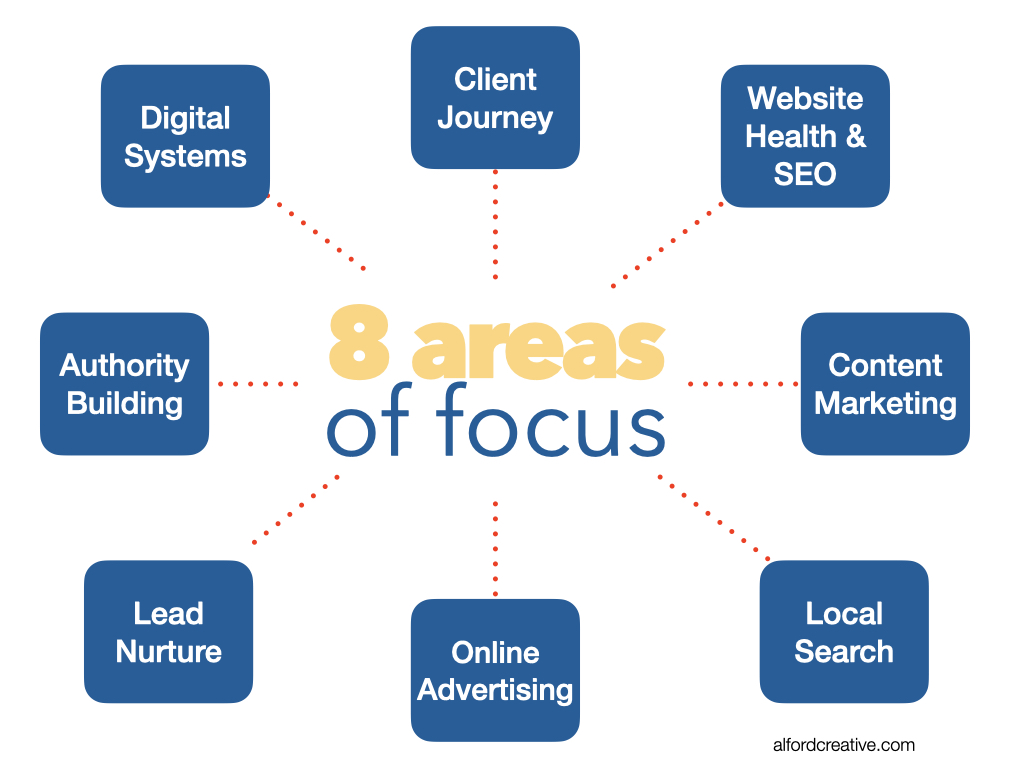If you’ve read my stuff, you know that I am a fanatic for strategy.
So much of the time we live our lives and do our jobs focused on what is three inches in front of our noses, which can cause us to not see the big picture and miss important gaps.
Marketing is one of those areas, where it is tempting to throw ideas against the wall and hope something sticks!
Hey, I get it. 
As small business owners, we wear many hats and marketing is just one…more…thing, But the hard truth is that there is too much crap advice being thrown around and too many of us wasting time on things that aren’t moving the needle on our business growth.
So today, I want to give you a sneak peek inside how we work with our most successful clients and offer up a proven framework that will make sure your marketing engines are humming on all cylinders.
A Common Thread to Success
After many years of helping clients get outstanding results in their online efforts, we decided to look a little deeper into what made our most successful clients successful and we found a common theme.
We noticed that our most successful clients cared about approaching the work from a thoughtful mindset. Instead of just spinning their wheels, they worked with us to create a cohesive marketing system around the following eight areas.
Crafting this type of balanced strategy means that you can weather storms, such as when social media companies change their algorithm or economic dips from a pandemic. You can be flexible and nimble, with more resources for success.
Companies that rely on just one area are much more susceptible to catastrophe in a changing market and can’t plan well for the future.
Okay….let’s get to it!
Eight Areas Of Focus
Marketing involves more than just slapping up some Facebook posts and calling it a day. There are eight areas that we are constantly monitoring and planning to make sure that your online presence isn’t lopsided or too reliant on one thing.
1. Customer Journey
The Customer Journey is the path your visitors take into and throughout your website to take action and become a client. It’s common to spend lots of time trying to attract visitors, but marketing doesn’t stop once visitors arrive at your website.
There are lots of elements we look at when constructing a customer journey, but must-haves include really knowing your audience, a strong first impression, clear navigation and targeted messaging so that people stay long enough to browse around. It also means a clear intake process, whatever that means in your environment.
It is the job of the website to move people to action, which means you must know what you want them to do. Take some time and plot the way you imagine someone moving through your site and then do the work to fix the gaps.
2. Website & Health & SEO
Websites can be the most important cog in your marketing engine if you treat it seriously. Just building it is not enough, you must pay attention to how healthy it is and make sure it is always being optimized so that the search engines can find it.
Google and other search engines have a few buckets of things they use to determine if your site is good enough to share the content with its searcher. Must-haves include having proper URL structure, security certificates and monitoring software, site speed, regular updates, sitemaps, analytics and making sure that each page has been optimized with the proper tags and metadata around the right keywords.
Most importantly, website health and SEO is not something that you can just set and forget. It is a vital and dynamic system that if monitored regularly will pay huge dividends in your growth.
3. Content Marketing
The internet exists because people want content, so we advocate for using content marketing as the foundation for all of your marketing efforts.
‘Content’ simply refers to the material you post and publish on your website, blogs, newsletters and across social media; text, videos, podcasts, pdf, e-courses and more.
Each piece of content works together to tell your unique story and helps potential customers decide if they can trust you with their business.
- Your content establishes YOU as someone worth listening to
- People will want to come back for more of YOUR wisdom and advice
- This process builds TRUST
- These people will eventually become your CUSTOMERS
4. Local Search
Local searches account for nearly half of all Google searches, where people are trying to find someone nearby, or in a specific geographical area. Winning at local search is a little different than the way you think about traditional SEO, but is an added resource for local businesses.
Must-haves for local search include setting up a Google my Business account, using local references on your website, managing reviews, understanding citation building and NAP consistency, and placing your info on to relevant directories where users can find your contact information.
5. Online Advertising
Generally speaking, there are two ways to get traffic to your website – organic and paid. Organic is when you use the tried and true tactics above (SEO and content) that require your time and effort over money. Digital advertising is when you pay for content distribution on various channels such as social media or Google Adwords.
Basically, paid ads speed up your content distribution and sometimes there can be valid reasons when that is important. The problem is that you don’t want to use paid ads as an exclusive measure, because it is a beast you have to continue to feed. Also, if you are wading into this space, you need to be aware that it is getting very complicated and often requires expert help to navigate and do properly.
We have found that there is often a space for both in a robust and balanced marketing plan. Must-haves include tracking pixels on your site, using targeted landing pages, targeting a specific audience with a specific promise and having specific goals and KPI’s for all campaigns.
6. Lead Nurture
So, how do you get people who have shown interest through your content marketing, SEO or paid ads to take the next step of action? Nurturing leads varies depending on the industry, but in all cases it is about staying top of mind so that people remember you when they are ready.
In today’s marketplace, you have to build trust before people want to buy from you. Statistically, that means they need to see your 5-7 pieces of content before they are ready to engage.
Must-haves for lead nurturing include keeping a CRM or leads list, having a plan for how often and how you will reach out, having automatic emails in place for funnels or campaigns, and setting up an email/automation system that fits your business.
7. Authority Building
All of the areas we have discussed so far contribute to some degree to building authority, but we also monitor some very specific things for those who want to be more aggressive in their market.
Must-haves for authority building include building important relationships with other influencers in your field, social proof and having a system in place to plot and track all of the potential opportunities for connection and PR.
With our clients, we use a tool called a Market Map, a working document to keep track of all of the opportunities and contact info for speaking engagements, guest blogging, being on podcasts, etc. There is nothing fancy or magic here, just a system to be intentional about going after the right opportunities.
8. Digital Systems
Increasingly, many parts of our businesses have a digital component and staying on top of how these connect with your website will ensure that you have great success at capturing more interested clients.
As consumers, we are used to seamless processes and ease of use, and we will often leave a site that is clunky, outdated, or asking us to do things (like download a pdf-yikes!!) like it was still 2002.
Working with your client journey, we encourage you to make sure you have digital solutions that will make for a better user experience for your website guests and clients. These will vary depending on the business, but might include digital intake forms, appointment calendars, online registration for events, employee onboarding and training and much more.
Need a Little Help With Your Marketing Strategy?
As you grow, it is easy to develop gaps in your marketing. Join me for a friendly chat to explore your business needs, analyze your online presence and brainstorm your next steps.
You will come away with 3-5 things you can do right away to create a vibrant online presence that gets you results! Schedule your video chat below.


